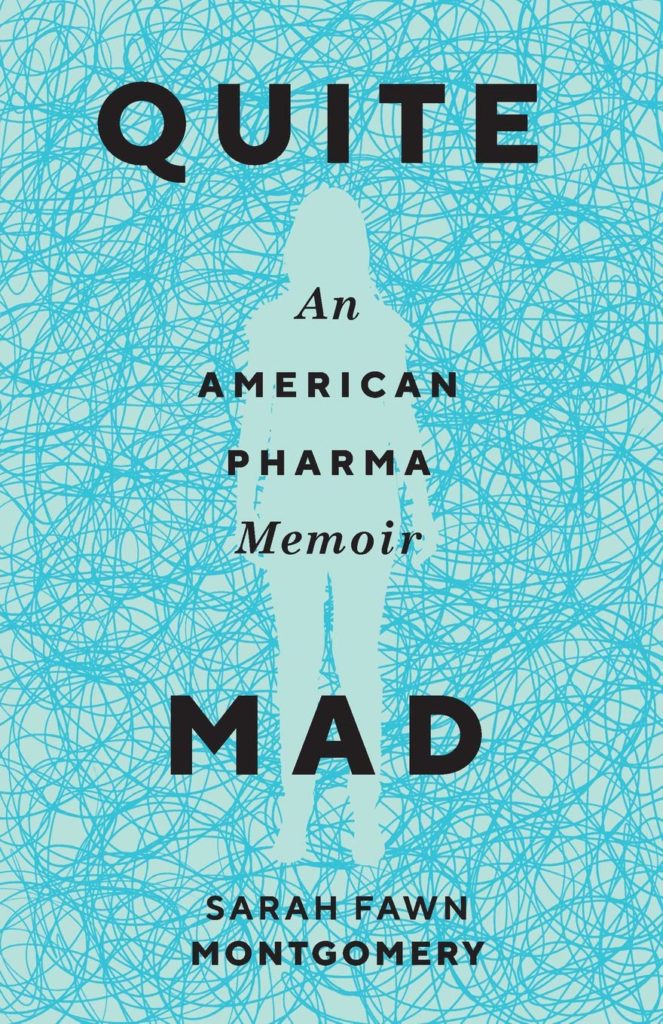review by Cate Hodorowicz
 In recent months, excellent memoirs and essays about women’s health have shed light on the medical establishment’s disregard for women’s physical, mental, and emotional pain. Add to this growing body of work Sarah Fawn Montgomery’s well-researched and deeply affecting Quite Mad: An American Pharma Memoir (Mad Creek Books), which traces the writer’s ten-year struggle to manage and understand her crippling anxiety, OCD, and PTSD.
In recent months, excellent memoirs and essays about women’s health have shed light on the medical establishment’s disregard for women’s physical, mental, and emotional pain. Add to this growing body of work Sarah Fawn Montgomery’s well-researched and deeply affecting Quite Mad: An American Pharma Memoir (Mad Creek Books), which traces the writer’s ten-year struggle to manage and understand her crippling anxiety, OCD, and PTSD.
Montgomery writes the book from “afterward,” explaining of her hard-won improvement, “[t]here is something reassuring in knowing time has passed.” But her story terrifies: panic attacks render her afraid to drive, she sees her kitten’s yawns and blinks as harbingers of death, she believes restaurant staff poison her food, her feet and hands go numb, she begins to black out.
In what women know as a familiar and infuriating experience, Montgomery discovers physicians who won’t listen to her. Instead, they conduct a trial-and-error approach to medication while dismissing side effects like Montgomery’s explosive rage and chronic hair loss.
Quite Mad moves deftly between this heartbreaking pharmaceutical journey and a satisfying cultural history of U.S. mental health. While Montgomery probes the ‘pharma’ of the title—particularly how profit drives and rewards medication-driven approaches to mental illness—she also delves into the representation of women and madness in literature; the links among mental health, faith, and gender; lobotomies and electroshock therapy; and society’s simultaneous fascination with and fear of the mentally ill.
While a chronological arc traces Montgomery’s ordeal, chapter interiors probe a tumultuous working class upbringing she never considered significant, let alone traumatic. Of her lineage, Montgomery observes, “Women’s silence is learned . . . There is no time, no space for weakness, for emotion, for the indulgence of madness.” In this, Quite Mad is also the tory of working class women who for generations have muzzled emotional pain, especially surrounding rape. They—including Montgomery’s family—consider therapy suspicious, a luxury, or both; many quietly medicate the mental illness they don’t, or can’t, claim.
Quite Mad also illustrates the challenge of building an academic career while living with mental illness. Now a tenure-track professor, Montgomery in her memoir perseveres through graduate school, teaching, and the academic job market all while hiding her condition. The book demonstrates a marvelous and at times frustrating tension between the voice of the logical scholar who needs to maintain her livelihood (and publish a ‘serious’ work of nonfiction), and the anxious, chaotic, brilliant mind beneath the professional mask.
Before her dive into nonfiction, Montgomery wrote two books of poetry, and some sentences of Quite Mad break away from careful statistics and narrative to bring her experience more lyrically alive:
There are ropes around my feet, holding me down, and when I bend to untie them they are vines that grow and grow and take root even deeper. And then they are serpents that wind their ways back through time. There is a salamander in my throat, his black body slimy with regret, his claws piercing my words.
This fierce, chilling language invites readers more intimately into the experience of mental illness, and although Montgomery notes, “Pain destroys language for patients, destroying patients as well,” her facility with words suggests possibilities through which new descriptions of madness and pain can bring reader and writer closer together. More of this description would be most welcome, but the book’s undercurrent suggests such an approach might be dangerous for a woman trying to climb the academic ladder.
While the medical establishment might not have viewed Montgomery as a fully realized person, readers certainly will, and they will appreciate her struggle, imperfections, and openness, all of which demonstrate how to live and empathize with madness. One of the most affecting parts of the book examines her marriage to a man who is bipolar. A spectrum of patience, compassion, frustration, and deep care characterizes a complex, rarely offered portrait of a long-term partnership; it is a lesson on how to hold hands while walking through fire.
One hopes more books like Quite Mad will find a way through language to describe the visceral, hellish, hopeful, and even “glittering” possibilities of mental illness that too many in this country still bear in isolated silence and shame. But as Montgomery so wonderfully shows us, “Mental illness is a braided part of identity, impossible to tease out. There is not illness and man, symptom and personality. Like a Venn diagram, they merge and shade one another. To wish illness away is to negate the man himself.”


